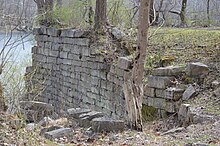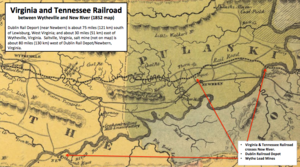
Radford is an independent city in the U.S. state of Virginia. As of 2020, the population was 16,070 by the United States Census Bureau. For statistical purposes, the Bureau of Economic Analysis combines the city of Radford with neighboring Montgomery County.

Courtland is an incorporated town in Southampton County, Virginia, United States. It is the county seat of Southampton County.

The Jackson Ferry Shot Tower is a 75-foot (23 m) tall tower used for manufacturing lead shot located in Wythe County, Virginia and now adjacent to the New River Trail State Park, a lineal rail trail park connecting the historic towns of Pulaski and Galax, Virginia.
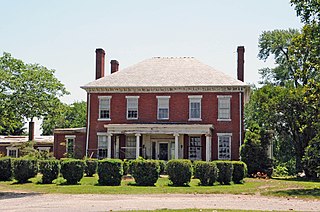
Varina Farms, also known as Varina Plantation or Varina Farms Plantation or Varina on the James, is a plantation established in the 17th century on the James River about 10 miles (16 km) south of Richmond, Virginia. An 820-acre (330 ha) property was listed on the National Register of Historic Places in 1977 as "Varina Plantation". At that time it included two contributing buildings and one other contributing site.

Buildings, sites, districts, and objects in Virginia listed on the National Register of Historic Places:

Mary Draper Ingles, also known in records as Mary Inglis or Mary English, was an American pioneer and early settler of western Virginia. In the summer of 1755, she and her two young sons were among several captives taken by Shawnee after the Draper's Meadow Massacre during the French and Indian War. They were taken to Lower Shawneetown at the Ohio and Scioto rivers. Ingles escaped with another woman after two and a half months and trekked 500 to 600 miles, crossing numerous rivers, creeks, and the Appalachian Mountains to return home.

The Draper's Meadow Massacre was an attack in July 1755, when the Draper's Meadow settlement in southwest Virginia, at the site of present-day Blacksburg, was raided by a group of Shawnee warriors, who killed at least four people including an infant, and captured five more. The Indians brought their hostages to Lower Shawneetown, a Shawnee village in Kentucky. One of the captives, Mary Draper Ingles, later escaped and returned home on foot through the wilderness. Although many of the circumstances of the massacre are uncertain, including the date of the attack, the event remains a dramatic story in the history of Virginia.

The Bridgeport Covered Bridge is located in Bridgeport, Nevada County, California, southwest of French Corral and north of Lake Wildwood. It is used as a pedestrian crossing over the South Yuba River. The bridge was built in 1862 by David John Wood. Its lumber came from Plum Valley in Sierra County, California. The bridge was closed to vehicular traffic in 1972 and pedestrian traffic in 2011 due to deferred maintenance and "structural problems".

The Casselman Bridge is a historic transportation structure on the Casselman River, located immediately east of Grantsville in Garrett County, Maryland. The bridge was built in 1813-1814 as part of the National Road. Historic markers posted at each end read:
Erected 1813 by David Shriver Jr.,
Sup't of the "Cumberland Road". This 80 foot span
was the largest stone arch in America
at the time. It was continuously
used from 1813 to 1933.

The Emmanuel Church at Brook Hill, in the historic community of Brook Hill in Henrico County, Virginia, is a historic Episcopal church.
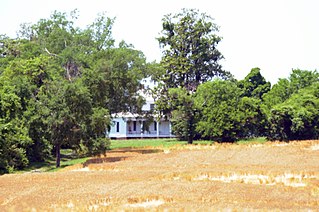
Tree Hill near Richmond, Virginia, in Henrico County, Virginia, is a Greek Revival style plantation house overlooking the James River about two miles east of downtown Richmond near the intersection of the historic Osborne Turnpike and New Market Road. Currently still a private farm, but expected to become partly a park after housing and commercial development, it was once owned by Richmond distiller and landowner Franklin Stearns, a prominent Unionist during the American Civil War. Centuries earlier, it had been a Native American camp site, and the birthplace of powerful chief Powhatan (d.1618).
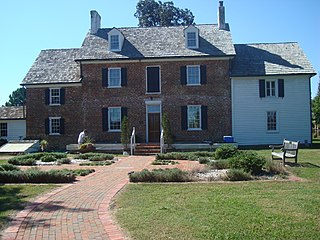
Ferry Plantation House, or Old Donation Farm, Ferry Farm, Walke Manor House, is a brick house in the neighborhood of Old Donation Farm in Virginia Beach, Virginia. The site dates back to 1642 when Savill Gaskin started the second ferry service in Hampton Roads to carry passengers on the Lynnhaven River to the nearby county courthouse and to visit plantations along the waterway. A cannon was used to signal the ferry, which had 11 total stops along the river. The first ferry service was started nearby by Adam Thoroughgood.
Newbern is an unincorporated community in Pulaski County, in the U.S. state of Virginia. From 1839 until the court house burned in 1892, Newbern was the county seat of Pulaski County

Windsor Shades is located on the Pamunkey River in Sweet Hall, Virginia, United States. It is listed on the National Register of Historic Places. Archeological native artifacts found on the property surrounding the house suggest it was the site of Kupkipcok, a Pamunkey village noted on John Smith's 1609 map.

Ingles Bottom Archeological Sites is a set of archaeological sites, and national historic district located along the New River near Radford, Montgomery County, Virginia. The district encompasses a variety of archaeological sites relating to human occupation from 8000 B.C. to the present. It includes the site of a log cabin built about 1762, as the home of William Ingles (1729-1782) and his wife Mary Draper Ingles (1732-1815). The property also includes the site of a stable, the Ingles family cemetery, a tannery, a blacksmith shop, and the Ingles Ferry Tavern.

Glencoe Museum is located in a Victorian house in west downtown Radford, Virginia. The house was built in 1870 in the 19th century Victorian style, specifically Second Empire, and was the home of Confederate Brigadier General Gabriel C. Wharton. It is a large, two-story, five-bay, brick dwelling, and originally had quite extensive grounds. The original house had a barn, chicken coop, smoke house, and an ice house.
Samuel Stalnaker was an explorer, trapper, guide and one of the first settlers on the Virginia frontier. He established a trading post, hotel and tavern in 1752 near what is now Chilhowie, Virginia. He was held captive by Shawnee Indians at Lower Shawneetown in Kentucky for almost a year, before escaping and traveling over 460 miles to Williamsburg, Virginia, to report on French preparations to attack English settlements in Virginia and Pennsylvania. He later served as a guide under George Washington during the French and Indian War.
William Ingles, also spelled Inglis, Ingliss, Engels, or English, was a colonist and soldier in colonial Virginia. He participated in the Sandy Creek Expedition and was a signatory of the Fincastle Resolutions. He was eventually promoted to colonel in the Virginia Regiment. His wife, Mary Draper Ingles, was captured by Shawnee warriors and held captive for months before escaping and walking several hundred miles to her settlement. William's sons, Thomas and George, were also held captive, although William was able to ransom his son Thomas in 1768. William Ingles established Ingles Ferry in southwestern Virginia.
Thomas Ingles was a Virginia pioneer, frontiersman and soldier. He was the son of William Ingles and Mary Draper Ingles. He, his mother and his younger brother were captured by Shawnee Indians and although his mother escaped, Thomas remained with the Shawnee until age 17, when his father paid a ransom and brought him back to Virginia. He later served in the Virginia militia, reaching the rank of colonel by 1780.
Dunkard's Bottom was a Schwarzenau Brethren religious community established on the New River in the mid-1740s by brothers Samuel, Gabriel and Israel Eckerlin and Alexander Mack Jr. It flourished for only a few years until most of the settlers decided to return to Pennsylvania because living conditions at Dunkard's Bottom were too harsh. The Eckerlins sold their property in 1753 and moved to what is now West Virginia. The property changed hands several times until the construction of the Claytor Dam in 1939, which submerged the area of Dunkard's Bottom under Claytor Lake.
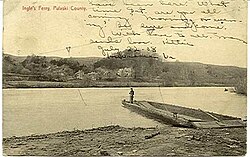



![1814 map of Virginia showing "Inglish Fer[ry]" in the lower left quadrant. A new map of Virginia with Maryland, Delaware & v. LOC 2008621667.jpg](http://upload.wikimedia.org/wikipedia/commons/thumb/7/70/A_new_map_of_Virginia_with_Maryland%2C_Delaware_%26_v._LOC_2008621667.jpg/300px-A_new_map_of_Virginia_with_Maryland%2C_Delaware_%26_v._LOC_2008621667.jpg)
